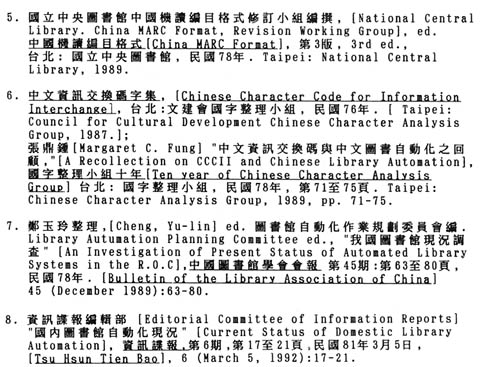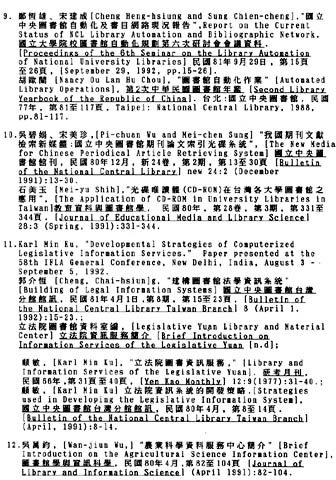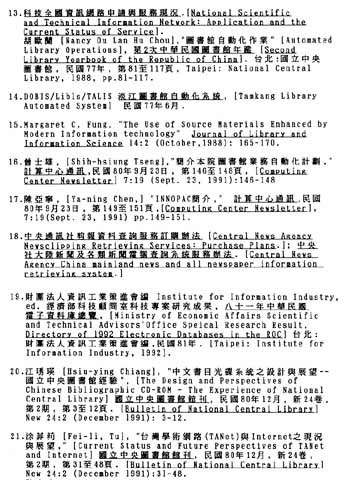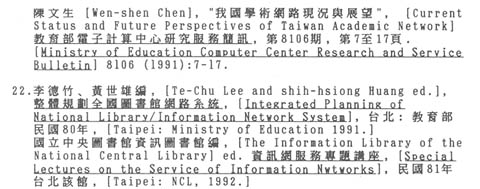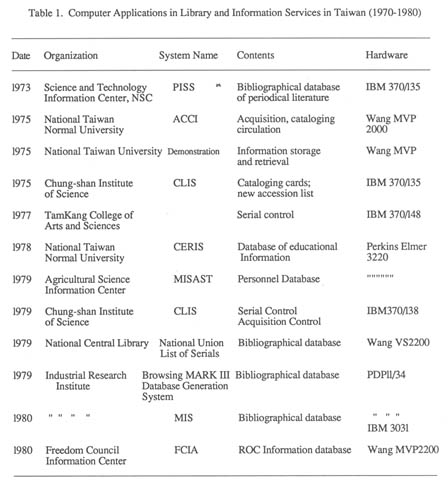
Margaret C. Fung
Department of Education
National Chengchi University
Mucha, Taipei, Taiwan
Keywords: New Information, Information Services, Information Industry, Network, Standards, Computer Aided Service,Taiwan, Taiwan Miracle, Library Automation, Chinese MARC, AACR II, ISBN, ISSN, NCLAIS, NCL, National Central Library,1. INTRODUCTIONInformation System, Database, CD-ROM, Communications, TANet, Taiwan Academic Network.
Abstract: This paper presents the state-of-art on the technological applications for library and information services on Taiwan, ROC. A brief description of the overall developments, pertinent standards, various computer aided information services, and networks are reported. Certain issues and problems experienced by Chinese library/ information practitioners will also be pointed out.
The importance of information industry and information services has been universally and unanimously recognized; information is considered indispensable for all endeavors. Information industry has become one of the major enterprises instrumental to the overall modernization and national development for the ROC on Taiwan in the last decade. It has been identified as one of the important strategies creating the "Taiwan Miracle." (1)
Increasing numbers of computer hardwares were manufactured and exported in the past ten years. In l98l, the export value of computer hardware here was ll0 million US$, in 1982, US$l60 million, in l985, l,222 million dollars, US$2,071 million dollars in l986, 5,000 million US dollars' worth in l988, 5,245 million US dollars' worth of products exported in l989 and 5,873 million US$ worth of computer exported in l990. A remarkable growth of 52 times in ten years. A total of l0,287 sets of computers were installed in various organizations in Taiwan by June of l990 and in l991, the total amount of computers installed reached ll,897 sets. A growth rate of l5.9% is seen. (2)
In the early l960s, government agencies started using computers for data processing and office automation, such as tax administration, the national defense administration, and the budgeting/ auditing administration, etc. Information services have also been given due attention. With the purpose of integrating planning, the Government organized a special group to study various issues and completed a preliminary blueprint for national information systems which include general admi-nistrative information system, economic information system, national security information system, communication information system and scientific and technological information system to be developed by the pertinent government agencies. Library information system has been incorporated into the scientific and technological information module to be coordinated and developed by the Ministry of Education and the National Science Council.
Several national development plans have exerted direct impacts upon the development of library/ information services. The l2th national development projects announced in l978 ushered the Cultural Construction which prompted the establishment of cultural centers, county and town libraries, and in turn enhanced library/ information service all over the island. The recently inaugurated the Six-year National Development Plan will further accelerate more programs for the development of computer applications for library/ information services. For example, NT$l,800,000,000 (the equivalent of US$72,000,000) is approved for the National Central Library's various projects which includes almost NT$810,700,000 (US$32,500,000) for its computer application projects. Another NT$l,384,350,000 (equivalent of US$55,375,000) has been estimated for library automation at the Taiwan Branch of the National Central Library. (3)
2. EXPERIMENTS OF COMPUTER APPLICATIONS FOR LIBRARY AND INFORMATION SERVICES (l970-l980)
Computer applications for library/information services initiated in the early l970s were experi-mented on the compilation of union lists, production of catalog cards, acquisition, serial control, and creation of bibliographical databases. Facilitated by better international communication system made available by the Universal Database Access Service UDAS, National Taiwan Normal University Library introduced Orbit and Dialog into Taipei in l979. The various applications made in the first decade are stated in the Table 1. (4)
3. STANDARDS
In general, the above experiments of computer applications for library/information services have been successful. They were somewhat handicapped by lack of integrated planning, lack of standards and inadequate use of computer as a processing tool. Instead, in most cases, it was primarily used as a printing device. The effectiveness of library automation was not fully utilized at the time.
It came to my notice that unless we have the following tools completely ready, we could not fully be benefitted by the expected efficiency of computer applications for library and information services - the efficient bibliographical control and the effective use of information resulting in the ultimate library objective of resources sharing. My proposal made to National Central Library and to the Library Association was kindly accepted and duly implemented. The proposal suggested the formulation of pertinent standards/rules to be consistent with pertinent international standards:
• The formulation of Chinese MARC (Chinese Machine Readable Cataloging) Format;
• the revision of Chinese cataloging rules to be consist with AACR 2 (Anglo-American Cataloging Rules II);
• the adoption of ISBN (International Standards Book Number) and ISSN (International Standard Serial Number);
• the formulation of standard subject headings.

3.1. Chinese MARC Formats
The Library Association of China and the National Central Library jointly organized the Committee on Library Automation Planning in April l980 to study, formulate, promote and execute the above proposed projects. The first edition of Chinese MARC format (using UNIMARC as reference) was published in January of l982; China MARC formats have been completed for monographs, analysis periodical literature and authority authority files etc (5). With the exception of the project of subject headings, all of the proposed standards have been completed. Some of them, such as Chinese MARC Formats are under going revision and updating to meet the needs prevailed.
3.2. Standard Character Set
In addition to the above standards, the most important one was the standard Chinese character set for information interchange. The need for such a character set was first mentioned to me by Mrs. H. Avram of the Library of Congress and was again expressed by Dr. John H. Haeger who was sent by the American Council of Learned Societies to visit Taipei exploring the possibility of a standard character set for Chinese characters used by Chinese, Japanese and Koreans. To meet the urgent national and international needs, Chinese Character Code for Information Interchange based on ISO 646 and ISO 2022 was devised since l978. (6) Up to l992, this set, covering 59,832 characters, has been successfully adopted by the Library of Congress and RLIN first under the name of REACC and later of EACC. Several international conferences and seminars, such as International Conference on Chinese Library Automation (February l981), Conference on International Cooperation in Chinese Bibliographical Cooperation (August l982), A workshop conducted at ASIS Annual conference (October l982) have all been conducted specially to discuss Chinese library automation related issues. The structure of this character set is described on the attached Figure 1.

4. AUTOMATED LIBRARY/INFORAMTION SYSTEMS
Computer applications for library/information services have been proceeded with great interest on this island. This phenomenon is evidenced by the following statistics resulted from two surveys.
In l988, a survey indicated that out of the sixty four libraries surveyed, forty six libraries responded. Certain operations of thirty five libraries have either been automated or planned to automate. (7)
The Ministry of Education reported in l990 that out of two hundred sixty libraries surveyed, sixty nine libraries (26. 54%) did not have plans for automation, 191 libraries (73. 46%) completed library automation or were in planning process. (8)
Major Endeavors
National Central Library
In l979, the National Central Library experimented
its first automated library system by building up the bibliographic database
of national union list of serials with Wang VS 2200. It expanded the hardware
and software to offer NCL automated information service (NCLAIS). Up to
June l992, the following databases consisted a total of 644,899 bibliographic
records: (9)
• Index to Chinese periodical literature (273,757 records),• Index to Chinese Gazettes (65,420 records),
• Monographs (287,8ll records)
• Chinese rare books, (l7,911 records).
NCLAIS offers the following services:
• Computer-produced items including catalog cards, Catalog of Books Published in the ROC, Index to Periodical Literature; Index to Chinese Official Gazettes, Catalog of Administrative; Government Publications, National Union list of Chinese; Periodicals, and the Union Catalog of Western Periodicals; of the Humanities and Social Sciences;• Online Information Retrieval system for the above mentioned databases. All information is accessible through the following access points: title, author, subject headings, ISBN, ISSN, Coden, Chinese Classification numbers and call numbers, etc.
• On line information retrieval services to search databases provided by DIALOG, MDC, and OCLC.
• CD ROMs of databases.
• Housekeeping functions of acquisition, cataloging, serial control, readers control, statistics, etc.
• OPAC for its collection.
The National Central Library, being the library
of libraries in Taiwan, started its National Bibliographic Information
Center which offers on line cooperative cataloging - Chinese CATSS (Chinese
Cataloging Support System) in l988 by installing Tandem with the assistance
of UTLAS and SYS COM Co. The online cooperative cataloging with sixteen
university and college libraries was officially operated on October 30,
l981.
Member libraries include Chung Cheng University, Chung Hsing University,
Chiao-tung University, Cheng-kung University, Chengchi University, Kaohsiung
Normal University, Hsinghua University, National Taiwan University, National
Taiwan Institute of Technology, National Taiwan Normal University, National
Yangming Medical College, Ocean University and National Institute of the
Arts, etc.
This database covers l70,449 pieces of CIP bibliographic records, l84,241 records of Chinese publications, and 3,949 bibliographic records provided by participating libraries.
It also provides CD-ROM for the l00,000 bibliographic records of books, serials, maps, and microforms collected during l980 and December of l989. The CD-ROM of the ~u2;Index to Chinese Periodical Literature is also made available by a system designed by the Institute for Industrial Technology which successfully presented the first Chinese CD ROM on April l5, l991. It covers l57,360 articles published in l,l6l Chinese periodicals from March l972 to September l980. (10)
The hardware used by NCL for library automation is
rather diversified:
• Wang VSl00, l CPU (l6F), 4MB, WANG VS8460-32, l6MB 3 (3l4 MB) disks, 3 (288 MB) disks, and 3 (629 MB) disks, l (l GB) disk, 2 (l. 3 GB) disks 23 sets of 5425C terminals, 5 sets of Wang (280) PC, 6 sets of Wang (8280) P, 6 sets of Wang (8420) PC, 1 (9580) printer, ll (M4024) printers and one Laser (O:{-20) printer, l tape drive (WANG 2209V)• Tandem TXP system, 2 Tandem CPU with 4MB memory each, 6 (5l2MB) disks, 2 LPl70 printers, 49 (6557) workstations, 27 (P70, 4023) printers and one tape drive.
• PDP-ll/73 CPU with 2MB memory 2 (l40MB) disks, 4 Japanese and Korean terminals and four line printers used for its Japanese and Korean collections.
• IBM PC/AT for CD-ROM (640KB RAM; MS DOS 3. 3; hard disk (40 MB).
In addition, personal computers are used for
CD ROMs to search the databases provided by STICNET, to use the video disk
provided by the Ministry of Communications on international trade, economic
and financial news, and databases on news clippings provided by the Central
News Agency.
Legislative Yuan
Being the Congress, Legislative Yuan pays great attention
to the prompt acquisition of accurate and up-to-date information as it
is of great importance to the legislators in making legislative deci-sions.
In l98l, at the Legislative Yuan's 68th session, the legislators expressed
their strong desire for computer- based legislative information services.
In January l984, Committee on Computerized Information Management was organized
to initiate feasibility studies and plans. After careful study and evaluation,
in October of l987, Digital system was installed for the Legislative Automation
System (LEGISIS). During the past five years, great strides have been made;
as of May l992, six systems, having been completed and being made available
through the use of WAN (Wide Area Network) are: (11)
• Legislative Electronic Bulletin Board - providing information on meetings, important events in Taiwan, and decisions made by the Legislative Yuan;• Legislators' Interpellation Information System - searchable with l4 access points such as date, subject, name, etc.
• Chinese Legal information Service - providing full text of the laws of the ROC. Titles, texts, subjects, related articles, enacting dates, amending dates, etc are given.
• Chinese Laws Amendments Information System - providing codes amended by the Legislative Yuan since l970 which was the year when the Central Codes Standard was promulgated.
• Legislative Literature Information System - database of periodical articles and research papers published since l985 in the field of laws, politics, economics, finances, public administration and technical education, accessible with the following access points: subject, keywords, author, article title and journal title.
• Legislative News Information System - providing news clippings of l6 local daily and news-papers pertaining to important news.
The Legislative Information Services Center gets
access to some 500 databases made available by DIALOG and LEXIS/NEXIS.
It also provides DIAL ORDER downloading. Its cataloging, OPAC and serial
control modules are also implemented on VAX. Its hardware configurations
are as follows:
VAX 8530 (one CPU, 80MB memory )
Micro VAXII (for backups)
Hard disks: SA600, SA482, and three RASl.
Tape Drivers: TA79 and TA81
Two intelligent disk controllers, HSC70
l24 terminals and workstations
Microcomputers are used for the following two systems:
• Congressional Diplomat Information System - Keeping a record of foreign visitors to the Legislative Yuan, providing information on the date of visit, number of visitors, and activities, etc.• LEGISIS Thesaurus System - providing both Chinese and English indexing terms.
Agricultural Science Information Center
With the mission to gather, organize and provide
agricultural science and technology infor-mation, and to set up an agricultural
information system for the promotion of research endeavors of the nation's
agricultural community, the Agricultural Science Information Center, established
in l977, has devoted much efforts to computer applications. The Agricultural
Science and Technology Information Management System (ASTIMS), including
the following four databases is searchable on line: (12)
• Files on Agricultural Science and Technology Thesaurus (FASTEA or AGRITHESAURU)- consisting of 20,ll5 Chinese terms and 20,521 English terms, displaying synonyms, narrow term, broad term and related terms; being constantly updated;• Files on Agricultural Science and Technology Personnel (FASTEP) covers l6,073 profes-sionals specializing in agriculture, forestry, fishery, husbandry and food science, working in various administrative, educational, research institutions and public or private enterprises. There are fifty nine access points: name, birth date, graduating year, degree, dissertation contents, major, office, position, job description, language, examinations taken, examination year, examination category, special professional training, memberships, patent content, patent year, honors, paper presentation and language used in conferences etc.
• Files on Agricultural Science and Technology Projects (FASTEJ)- providing information on 24,999 research projects supported by the Commission on Agricultural Development. The access points include project number, project leader, project executors, persons responsible for the project, experts, cooperating agency, keywords, budget category, file number, classification, year, and source of budget. This database is useful in evaluation, project control, follow-ups and auditing, and research to be continued;
• Files on Agricultural Science and Technology Literature (FASTEL) - covering all research reports, periodical articles, conference papers, theses/dissertations, conference proceedings and papers since l980. They are accessible by using database number, subjects, keywords, authors, publication source, dates, classification name and number, holding library/unit, research report number, serial number, project number, ISSN and ISBN. The system is implemented on Prime 750
The Center also provides on line retrieving services
to 589 databases provided by DIALOG, ORBIT, BRS, ESA-IRS, STN, DIMDI, FOODLINE.
The Center's Library Automation System, consisting of bibliographic subsystem, authority control subsystem, serial control system, and acquisition subsystem, provides excellent technical services.
In addition, the Center recently acquired an image processing system from Filenet for the purpose of storing in the optical disks the texts of the materials mentioned in the above data- bases. The new endeavor will provide even more efficient services to its patrons after it is hooked up with VAX6420 with RS232 port.
The Center is in the transition period at the moment, it tries to convert their hardware from Prime 750 (4MB) to VAX6420 (2 CPU, 96 MB).
National Science and Technology Information Center, National Science Council
Being one of the pioneers in computer applications
for library and information services, it has created a unique service offering
access to the following 12 domestic and 6 international databases through
its STICNET (Science Technology Information Center Network) since l988:
(13)
Union List of Non-Chinese Sci-Tech Serials in the ROC;Union Catalog of Non-Chinese Sci-Tech Books in the ROC;
Sci-Tech Journal Articles of the ROC;
Humanities and Social Sciences Journal Articles of the ROC;
Ongoing Research Projects of the ROC;
Sci-Tech Research Reports of the ROC;
Sci-Tech Briefs;
National Science Council Awarded Research Papers Abstracts;
Conference Papers of Academic Societies in the ROC;
Abstracts of Doctoral Dissertations and Index of Masters' Theses;
Index of Domestic Sci-Tech Conferences and Seminars;
Technical Reports of the ITRI;
BIOSIS PREVIEWS; CA SEARCH; COMPENDEX; ERIC; INSPEC;
NTIS; SPORT; DAO.
STICNET, based on a retrieving software named
STATUS, was developed with Wang Laboratories and Computer Power Company.
It is implemented on WANG 7150 computers (36 MB CPU; hard disk of 9 GB)
Twenty six workstations and 24 IPCs are available for input and retrieval
at the Center. It is available to patrons in three different manners depending
on user environment: PC dial up, Wang host computer facilities or through
Taiwan Academic Network (see table in the following page).
Tamkang University
Based on the DOBIS/LIBIS, the Tamkang Automated Library Integrated System (TALIS), developed in cooperation with IBM, implemented on IBM 438l/Mll has been officially and efficiently in operation since November l986. (14)
This integrated library automation systems includes cataloging,OPAC, acquisition, serial control, circulation, interlibrary loan, etc. In addition to electronic mail system, it has recently added three other functions proven to be useful to the community: electronic bulletin board (announcements of new accessions, library hours, circulation regulations, etc), ranking of books and library statistics.
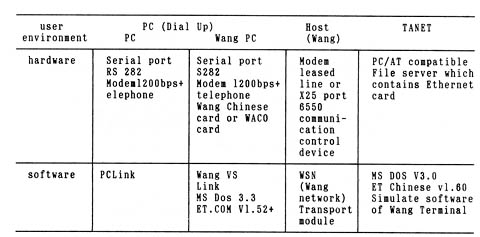
Academic Sinica
Being the highest ranking research institute in Taiwan, it has devoted much efforts to the research on automated library services and on-line retrieving techniques. Dr. Hsieh Ching-chun has made great contributions to the design of CCCII and full-text databases. Full Text Database for Chinese History, Chinese Electronic Dictionary (Kuo Yu Jih Pao Tze Tien), Data- base of Ancient Tombs, Household Registers during the period of l906-l947, Land Reports, Classification of Chinese Verbs for Parsing, Masters' Theses Database, Ming/Ching Dynasties Archival Materials Database, Academia Sinica Researchers' Biographical Materials and Works Database, etc. (15) Since Dr. Hsieh will present a paper at the Conference, I will not repeat the details here. The Academy's and Dr. Hsieh contributions to computer applications for library/information services should indeed be recognized with applause.
As far as library automation at the Academy is concerned, they tried URICA system for two years and five months. (16) It has decided to install a new system called INNOPAC which is developed by Innovative Interfaces Incorporated to be also installed by eight other college and university libraries: National Taiwan University, National Chengchi University, National Taiwan Normal University, National Yangming Medical College, Chung-cheng University, Kaohsiung Normal University, and Pingtung Normal College. The Academy has also tried to transfer the computer multi-media technology from the Industrial Technology Research Institute to produce a multimedia presentation of its Computer Center in the near future. (17)
Recent survey indicated that academic and research libraries show much interest in applying new technologies to library/ information services. New agencies and newspapers are particularly keen in exploring various means to upgrade their news collecting functions. Almost all the large news- paper publishers use computer facilities for production of their papers. The most sophisticated and modern facilities are used by United Daily News.
Central News Agency
Central News Agency has provided a special computer-aided information retrieving service with a database of news clippings collected from more than forty international and domestic Chinese newspapers. (18) The news clipping database covers various subjects ranging from politics, foreign affairs, international relations, business, society science and technology. They are classified into 8720 categories. In addition to news, special reports, editorials, special interviews, major events, and statistics are included. The system is made available with the following facilities: PC #80386 (8MB/MM) l. 2 GB of hard disk, SCSI interface card, Novell network card.
For the purpose of supplying information on China mainland, the Central News Agency developed Mainland News Computer Information Retrieving System with image processing technique. There are sixty thousand pieces of news clippings ready for retrieving with sixteen access points such as subjects, page number, descriptors, events, names, of person, geographic names, names of association/society, dates and keywords. Boolean logic is fully applied to information retrieval of this database.
5. DATABASES, CD-ROM AND NETWORKS
Reported by Directory of Electronic Databases In the Republic of China l992, in addition to the database made available through telecommunication or CD-ROM, many databases of various subject matters and of various nature (bibliographic, numerical, full text or directory) are either built or provided by various public or private organizations. (18)
Two hundred twenty nine databases are available with the follow distribution:
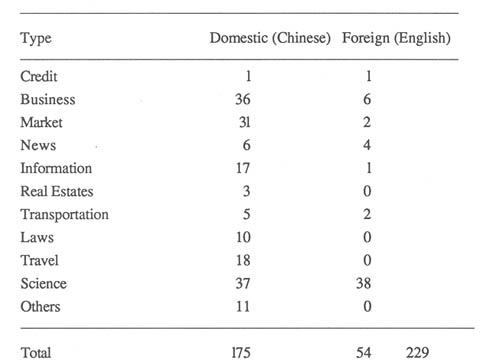
CD-ROM was officially introduced to this area in l987 when Bibliofile was brought in to assist the cataloging work of books in Western languages. Within a year, Bibliofile was used by seventeen academic and research libraries. Out of the 43 universities subsidized by the National Science Council to purchase books and periodicals, 37 libraries have acquired CD-ROM which covered 54 different subjects. (l9) Some databases such as Dissertation Abstracts Ondisc LISA, Sociofile, ERIC, Books in Print, MEDLINE ABI/INFORM, Social Science Citation Index, Science Citation Index, OCLC CAT CD450 and COMPENDEX available in CD-ROM format are popularly used. Facilitated by LAN, users find them very convenient even though some of the information retrieved may not be up-to-date. As mentioned above, National Central Library provides the first Chinese CD-ROM for its book collection and; Index to Chinese Periodical Literature which is considered a big step forward in technological applications. (20)
Information accessibility is greatly enhanced by various networks developed. Networks are instrumental to resources sharing which is the ultimate objective of library automation.
Some of the above mentioned databases are searchable
on line through telecommunication/networks. Tymnet and Telenet were connected
to our telephone company in December l979, the dial up service is called
Universal Database Access Service (UDAS). DIALOG, ORBIT and BRS are available
through which. Starting from l984, packet switching equipments enabled
us to be connected with the following:
AUSTPAC, MIDAS - Australia; DCS - Brussels;DATEX-P, RADIO - Austria; DATAPAC, GLOBDAT, CNCP - Canada;
TRASPAC, NTI - France; INTELPAK, DATAPAC - Hongkong
VENUS-P, DDX-P - Japan; DNS - Korea
LUXPAC - Luxemburg DATANETI, DABAS - Netherlands
TELEPA - Singapore TIDA, IBERPAC - Spain
DATAPAC, DATAC - Switzerland IPSS, PSS - United Kingdom
UDTS, BBS, LSDS, Tymnet, Telenet, Autonet, Uninet and CNS - United States.
BITNET (Because It's Time Netowk), brought in
by the Ministry of Education in June l987, laid a solid foundation for
TANet (Taiwan Academic Network) which is also now connected with Internet
(Figure 2). TANet, being an inter-campus network connecting colleges and
universities domestically and communicating with more than 5,000 networks
in 35 countries all over the world supports teaching and research, promotes
information sharing, facilitates electronic mails and file transfer. (21)
With such a fine communication environment created by this open system,
we look forward to much improved library/information service in the near
future. The entire library and information community is very enthusiastic
in developing efficient networks. Studies have been conducted with recommendations
to set up National Library/Information Network. (22)
6. PROBLEMS AND ISSUES
In the past, we experienced the following problems:
• Lack of overall planning -- most libraries started individual planning. Each library planned independently on its own without seriously considering the objective of resources sharing aimed by library automation. Each module of computer application for library/information service within the library was planned as an independent unit by itself. Diversified equipments in one institution or in several institutions of the same nature handicapped coordinated efforts.
• Lack of consensus and the will to cooperate among libraries. Each library wanted to have a system better or more unique than others.
• Lack of adequate amount of trained staff. Most librarians do not have adequate training in handling computer applications for library/information services. Computer science graduates do not understand the professional work required for librarianship.
• Lack of authorities in supervising operations and formulating policies.
• Redundancy of databases. As an example, let us take a look at the numerous databases of dissertations and theses which could have been consolidated.

Fortunately, we learned the hard way early, it is
not too late for remedies at the present time. Several recent plans for
library automations made by several libraries, the newly-developed networks,
and the promotion of integrated network planning, and the adopting of the
same software packages, seem to have indicated general awareness of the
existing problems and a strong will for correct directions of future endeavors.
REFERENCES
1. K. T, Li, "Policy Formulation in a Dynamic Economy: The Experience of the ROC on Taiwan," First Annual K. T. Li Lecture sponsored by the Center for International Affairs, Harvard University and Center for Continuing Education, National Taiwan University, October l5, l990.
2. Information Industry Yearbook, l990, p. 58; Information Industry Yearbook, l99l, p. 5l.
3. National Central Library, Strengthening National Library Development: 6-Year Plan, Taipei: NCL, l992, pp. 28-29; National Central Library Taiwan Branch, Taiwan Branch Library of National Central Library 6-Year Development Plan for, Taipei: NCL Taiwan Branch, l992, pp. l6, 29.
4. Margaret C. Fung, "Library Automation in the Republic of China," Journal of Library and Information Science, 6 (l ) (April l980):1-6.
